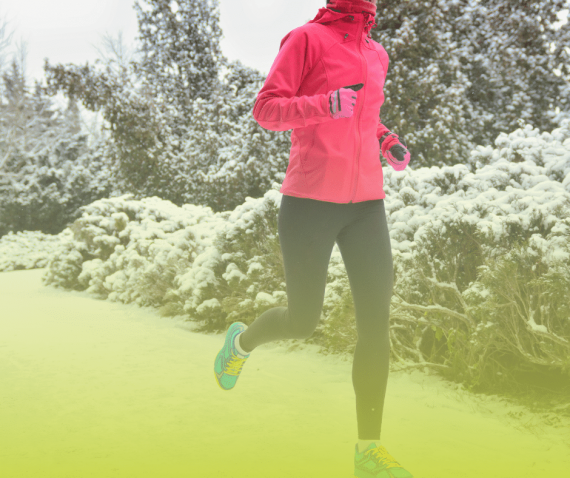How to train safe in the snow
Has the snow sent your outdoor fitness routine into hibernation? It can be challenging to find the motivation to head outside to exercise on a snowy day.
We all know that exercise can help banish the winter (and lockdown) blues, boost energy and prevent weight gain, so check out a few of our top tips to keep you going and injury-free.
DRY & WARM
Getting wet is by far the quickest way to lose body heat. Water is an effective heat conductor; it moves heat away from the body.
Wet fabric next to your skin will absorb your body warmth and give you an unwanted chill. So, skip activewear made from cotton, which soaks up sweat and rain, holds in moisture, and opt for synthetic fibres instead, such as polyester, nylon, and polypropylene designed to dry quickly.
LAYER-UP
You need layers to trap warm air next to your body and keep out the elements like wind, rain and snow. First, you need a thin base layer made of synthetic fabrics (as mentioned above). These fabrics pull the sweat away from the skin. And If it's really cold outside, wear a middle layer, such as fleece. Then, add an outer layer for added protection.
GO BRIGHT
Black may be the go-to colour for many of us, but bright clothes are better for outdoor exercise. Not only is it colder in winter, but it's darker too, which means poor visibility, making it challenging for others to see you.
Wear brightly coloured clothing and consider purchasing blinking lights and reflective clothing. As well as helping others see you, wearable lights improve visibility for you, too, helping prevent missteps and falls.
FINGERS, EARS, NOSE & TOES
Our fingers, ears, nose, and toes are affected most when the temperature drops. Wear a hat or headband and gloves to keep your extremities from freezing. You can take them off and tuck them in a pocket if you get warm. Thick socks also help keep your toes warm.
WINTER-PROOF YOUR SKIN
Dry skin in winter is common as the air isn't just cold; it's dry. To help prevent skin from drying out, drink plenty of water and use a good moisturising cream. Apply Vaseline to sensitive areas like the nostrils, tip of the nose, and ears for more protection when the temperature really drops.
And did you know you can get sunburnt in the winter! Even when it's cloudy, UV rays can reach and damage your skin. Plus, snow reflects up to 80% of UV rays, so basically when there's snow, we're hit by many of the same rays twice.
TRACTION
If you're planning to go for a run or even a walk on icy and snowy surfaces, attach ice spikes to your shoes. These will help maintain traction and reduce the risk of falls.
However, it's essential if you're wearing spikes to stay off the pavement. They are intended to pierce snow or ice, so they can impede balance instead on paved surfaces.
WARM-UP
A good warm-up is essential to prep for cold-weather workouts. Dynamic warm-ups enhance blood flow and temperature in our muscles and also helps reduce the risk of injuries. The risk of sprains and strains when exercising in colder temperatures increases. Think of it this way; if we stretch a cold rubber band, It will snap easily. Warm it up, and it becomes more flexible and less likely to fray.
REMOVE LAYERS
A big mistake in dressing for cold weather exercise is putting on too many layers and not peeling them off in time. Exercising will warm you, and you don't want to get too sweaty when you're in freezing temperatures, which will leave you at risk of everything from dehydration to frostbite.
As as you start to feel like your body temperature is around baseline, that's the time to start discarding layers. Bear in mind that your exercise intensity will affect how many layers you need. For example, runners generally need fewer layers than walkers because they move faster and produce more body heat.
DRINK
You may find you don't feel as thirsty during winter workouts as you do during warmer-weather workouts. However, you're still losing fluids through breathing in lower temperatures and sweating. Therefore, you must replace those fluids by drinking plenty of water.



